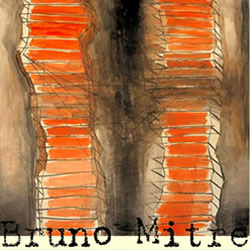
– A whole lot of wreckage: isn't it what we, post-moderns, wanted? "London | What are we complaining? When I look out the window here in Belsize Park, all I see is green, plants and I don't hear any automobile noise, for I live in a villa where cars don't go through. But this utopia seems ridiculous to me, I miss my last address. It was a business address: Kent Avenue, in Williamsburg, that avenue with the trucks rolling by and the piles of garbage by the edge of the East River. That's where I saw the World Trade Center attack. That's where I saw the towers fall. And that was where, in Ground Zero, that I serviced as a volunteer, the next 21 following days, in between those piles of concrete, remains of human disgrace and political asterisk, that I lived covered in toxic dust watching the most horrendous things. But it has been two years now. The images and sadness will never fad and my hatred for Bush's policy will also never diminish. However, I was able to create a large enough of a distance to see that mountain of remains as a monument, an edification to iconoclasm, to post-modernism and deconstructionism which we fought so hard for, campaigned, argued in the twentieth century. Yes, we were able to break the art molecule, as if art was science and did not depend on inspiration. Inspiration is not breakable and maybe it shouldn't have been as autopsied as it was, maybe it shouldn't have been so fragmented and put under the microscopic lenses, with each of its two cells demanding semiotics explanations. Dammit! The whole thing was such a bore. Against interpretation! How to read photography, all starting with Freud, all starting with Schöenberg deforming Wagner's notes, or Duchamp putting a urinal (very well humored) instead of a dull painting. The intention was of the best, at first, for investigation is part of human nature. John Cage was absolutely brilliant in his "Silence", as Andy Warhol was genius taking a can of soup out of anonymity from a supermarket shelf, singling it and putting it under the spotlights of fame. It was genius, again, when he reverted the game and did the same to Marilyn. Took her out of the spotlights and multiplied her like a can of soup and put her in supermarket shelves, making her accessible and multicolored. As said before, the intention was the best and good humored. Georges Duhuit was genius and all French semiologists were fantastic. But today, in retrospect, all of this seems like masturbating a limp penis. Forgive my terrible analogy. And from this excess of masturbation, came the manifests and the bad-mood. Came the Heiner Muellhers. His manifests (not at all theatrical; some of which I put together myself, such as "Quartett", with Tônia Carreiro and Sergio Britto another time with Ney Latorraca and Edilson Botelho and in New York with George Bartenieffe Crystal Field; or "Hamletmachine", at La MaMa in New York, as a workshop production) were true X-ray machines, that seeked to see mystical and mythical within the muse that builds art and from which art is made of: emotion, impact and intelligence. Trying to single out or comprehend such coordinates scientifically is attempting to comprehend why there is love and that, would honestly take all the fun away. Ergo, in a matter of a few years, we would have pharmaceutical laboratories making love pills, like the love elixir in Wagner's Tristan and Isold (still in allegorical form, in the Celtic legend). Deconstructionism, however, isn't only that pile of shard remains of nothing that I saw at Ground Zero and still see everywhere (metaphorically, Bush is turning the world into it). Deconstructionism was and still is a pharmaceutical lab that searched for formulas to reproduce, maybe even clone the unclonable, meaning, to play with the cycle of life and the cycle of creation which contains life and death and all the metaphors, allegories, parables and poetics that could be hidden behind that inexplicable muse who put us in the planet. How to reconstruct something? I don't know. I don't think anyone knows. Art is putrefying. Just drop by any gallery or read any young drama writer. It is all about suicide, moribund corpses, deformed, as if the chemical bomb had already hit us. It hasn't hit us yet. What has hit us was so much worse. We took an ideological shot and no one knows where it came from. It didn't come from the right, it's been there for decades. It didn't come from the left, as well. It vaguely reminds me of John Kennedy's death, a great mystery until today, because he didn't die caused by a single bullet shot by Lee Harvey Oswald. And the big question has always been: did he really die or just get into a neurovegetative state? Are we on that state? Do we know that? Are we aware of that? I look out my apartment window in Belsize Park and all I see is plants. I really do miss those noisy trucks on Kent Avenue, New York. They stank. Human stink is marvelous. The human stink that, at least, is alive." P.S.: Text presented at the individual exhibition of Bruno Mitre, at the Nello Nuno Art Gallery / FAOP – Fundação de Arte de Ouro Preto (Art Foundation of Ouro Preto). |

|
